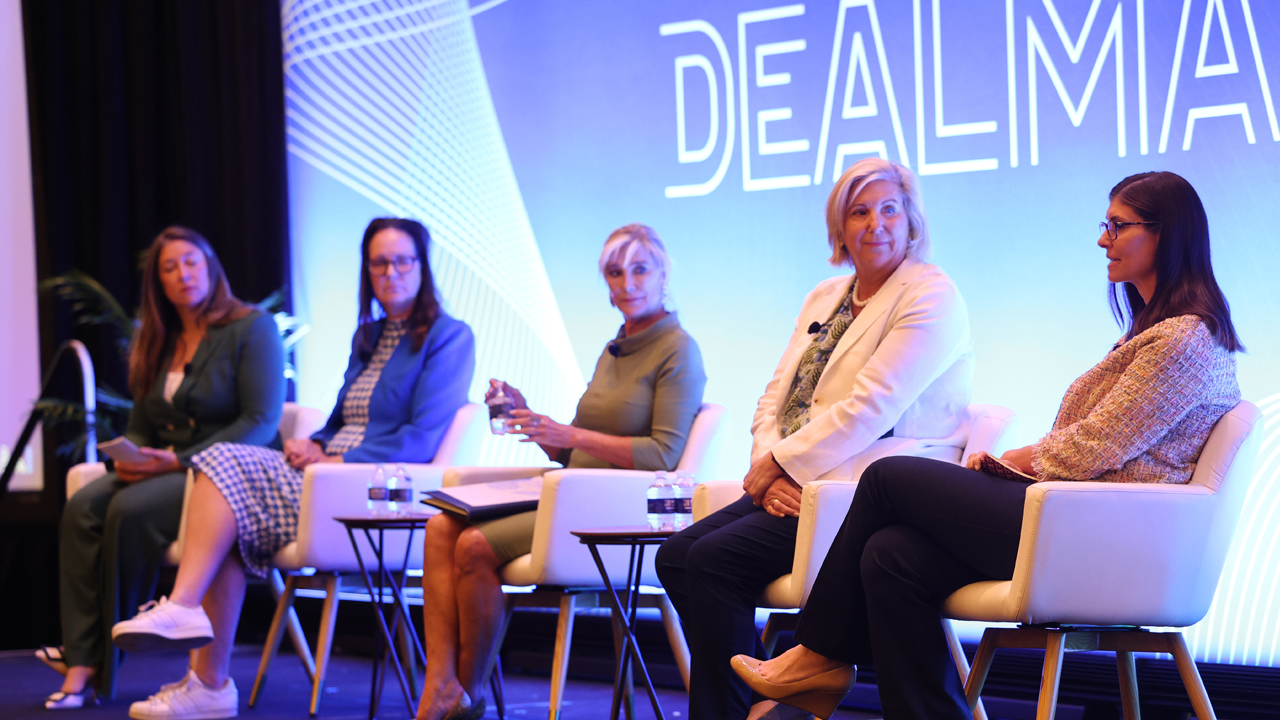Closing the Gender Gap at Senior Levels of Financial Services
Despite progress on gender diversity, the financial services industry remains imbalanced at its most senior levels. Speakers discussed this challenge at the women’s networking breakfast during ACG’s DealMAX.

Despite progress on gender diversity, the financial services industry remains imbalanced at its most senior levels, where men continue to outnumber women.
Speakers discussed this challenge at the women’s networking breakfast during ACG’s DealMAX conference on April 30 on a panel titled “Increasing and Enhancing Women’s Roles in the M&A Market through Smart Talent Acquisition Strategies.”
The panelists brought perspectives from investment banking, private equity and professional services executive recruiting to the discussion, which was sponsored by Grant Thornton. They talked about their own experiences balancing their personal lives while advancing in their careers, and shared suggestions for how firms can improve their track record of hiring and retaining women.
The panel was moderated by Melanie Krygier, Partner, Grant Thornton. Panelists included: Beth Cahill, President & Senior Managing Director, Windsor Capital; Erin Carroll, Partner, BraddockMatthewsBarrett LLC; Pam Hendrickson, Vice Chairman, The Riverside Company; and Gretchen Perkins, Partner, Avance Investment Management.
An edited and condensed transcript of the conversation follows.
ACG Event Recap
WHAT: “Increasing and Enhancing Women’s Roles in the M&A Market through Smart Talent Acquisition Strategies” at ACG’s DealMAX
WHERE: ARIA Resort & Casino in Las Vegas, NV
WHEN: April 30, 2024
THE TAKEAWAY: Panelists shared insights into managing the work/life balance and offered suggestions for how firms can improve their track record of hiring and retaining women.
Melanie Krygier: A recent McKinsey study showed that private equity firms have nearly achieved gender parity at the entry level; however, women in PE are still underrepresented in leadership positions and hold only 20% of managing director roles. How do firms turn the tide when it comes to retaining and promoting women?
Beth Cahill: I think balance is the most important thing that firms can start to adopt. Work doesn’t have to be a 9 a.m. to 5 p.m. arrangement—because it isn’t anymore. We are on 24/7; we’re stuck to these phones that go off at 11 o’clock at night. We take those calls, but that doesn’t mean that you can’t take time for balance in your family life. And firms need to begin to recognize that.
We all have different chapters in our lives. We need to recognize that and say, OK, even if I am involved in raising children or taking care of an elderly parent and my time commitment has changed for the day, I have other times that I can provide to the firm.
Back in the day, there was a movement to get rid of a lot of the middle-management fat. But there was a reason for the redundancy of skill sets, so that someone wasn’t the only person who could do a particular job. If you couldn’t do it, nobody else could, or you lost that slot because somebody else stepped in. I think firms need to go back to a little more redundancy.
Pam Hendrickson: A guy on a plane recently said to me something along the lines of, “Wouldn’t it be great if firms figured out a job that doesn’t require as much travel when you’re having children or when you’re taking care of an elderly parent?” And I thought, that is such a great idea. Plus, there are so many opportunities to work in a private equity firm in other roles, such as an operating executive or in capital markets, for example, where less travel is required.
Krygier: What have you seen from firms that have been successful in retaining women or promoting them to leadership roles?
Erin Carroll: From a recruiting perspective, it’s important for firms to ensure that they have a foundation of support. Do they have policies in place to attract employees? What do employees want and need if they’re going to spend their primary earning years at an organization?
During those primary earning years, individuals go through various seasons of life. It differs for every person, but it’s important to have foundational policies and transparency about what the firm has done, how it supports employees, and its talent development and leadership development map.
Cahill: I think with retention for women as a whole, we need to make sure that we take credit where credit is due. We all tend to say, “It was a collaborative effort,” or “Well, Jim helped me here.” Take credit. Stand up and be very proud of what you did. Find your voice. Talk about what you have done. Because often you’re the only woman in the boardroom, and you say something and it’s not adopted, but then somebody else parrots what you said and everybody thinks that’s the best idea.
Krygier: How do you think about the differences between mentorship and sponsorship, and how do those relationships advance gender diversity?
Gretchen Perkins: A sponsor is your champion internally, and it doesn’t need to be another woman. It should be one of the leaders—one of the power brokers—in your firm. They’re the person that’s going to go to bat for you in front of the investment committee or advocate for your promotion.
A mentor is another person, or a few of those people, either in the industry or your firm, whose valuable ideas, experiences and advice you can benefit from.
Carroll: Over the last decade-plus, we’ve seen connectivity between peer groups grow tremendously, especially for women across different functional areas. The information-sharing and the ability to ask questions in freeform-type environments has really changed. For example, there have been unofficial surveys on family leave within the lower mid-market versus the middle market versus larger firms versus different service providers. To be able to have those conversations and ask those questions with peers gives the market some intelligence and helps firms candidly reflect on themselves and how they can be better.
I continue to think the formation of both official and unofficial networking groups has been powerful. I’m sure in 10 years, this conversation will be a lot different because the individuals who are now associates, senior associates and vice presidents will be vice presidents, directors and managing directors. I’m really excited for what the next 10 years will look like, because I think this landscape will change a lot.
Related content: From Golf to Negotiation: ACG’s Women’s Groups Are Closing the M&A Gender Divide
Krygier: What strategies can firms employ to support the growth and development in gender diversity in the industry?
Cahill: I think that we need to be stronger in advocating for what we need. There’s movement for the four-day work week. Is that that good, bad, neutral? I don’t know. But we need to make sure that if we need time off, it’s available to us, and that remote work is real remote work where we’re committed and getting the work done. Even if that means after you put your baby to bed, you go back to the “office,” even if it’s inside your own home, and complete the task at hand—that shows your commitment. But you still had your time with your family.
Hendrickson: The pandemic probably had the greatest impact on remote work and proved that you can work no matter what. One of my analysts said to me recently, “You have no idea how much easier it is for me to move my clothes from the washer to the dryer at noon rather than midnight.” And I said, “Oh, yes, I do.” But at the same time, I think working in-person three or four days a week probably is the right mix. I do think people need some flexibility, but they also need community. They also need culture.
Carroll: I also think firms have to be honest about what I call the “title trap.” If you’re hiring an analyst on the investor relations team or an associate on the business development team, does that person need to have only two to five years of experience? Historically, and from a hierarchical perspective, that is the typical way that you would’ve recruited. But maybe an associate could have 10 years of experience and come from a different background. Maybe they came out of marketing and communications at another asset management firm. They could be another woman on the team and someone with leadership ability who brings a lot more experience. Thinking outside of the box and expanding parameters across hiring is another way to attract great women to M&A and private equity.
I’ve also spoken to a couple of individuals on the operating side, where they have almost job-share situations. If you are in human capital or commercial excellence and you’re in a season of life where you don’t want to work 50-plus hours a week, maybe a firm hires two of those individuals. They’re deployed across the portfolio, but instead of hiring one, they hire two, but the cost to the firm is equal in many ways. I think there are ways that firms can be more creative.
Perkins: This is a rigorous industry we’ve chosen to be a part of, and I think having more of us in it is great. But to continue, we need to maintain our enthusiasm for what we’re doing.
As you go through your career, there will always be times where it’ll be difficult to see how you could possibly keep doing this and be a good parent and a good employee. I would just encourage you to hang in there because, at a certain level, you have a lot of flexibility to create your schedule and meet your needs, provided you’re getting your stuff done. None of this implies that you don’t have to be great at what you’re doing, but we’ve talked about different ways to do it and different hours of the day to do it.
As to what firms can do, leaders could do a better job of being aware. For anybody who’s in a decision-making leadership role: Try to be attuned to what your employees are going through and offer some support. Maybe it’s employee assistance programs that help find a caregiver three days a week for my 88-year-old mother who lives in a different state than I do—things like that. Companies can do a lot to make life a little bit easier.
Cahill: I’m going to piggyback on the point about sacrifices, because this is a very rigorous industry, and you have to make some difficult life choices.
I do a lot of cross border deals, and because I always had children at home, when traveling I was always thinking about how fast can I get there and how fast can I get back? One time, I was going through German passport control and was asked, “How long will you be there?” And I said, “I’ll be leaving at two o’clock.” And the customs official asked, “You came for lunch?” I was like, “Yeah, I’m here for lunch. I have to get back to the kids.”
It’s a sacrifice you make, and it takes a toll on you and your body, but you have to make that decision. You may have time with your family during the day, but that means that you must make a commitment later that day to do your work. You have to perform—there’s an expectation for that.
Krygier: At the same time, for those in leadership roles: Don’t limit someone because you assume that it’s going to be too hard. Let them make that decision for themselves. There are plenty of people who are more than willing to make that sacrifice when asked to go to Germany for lunch.
Katie Maloney is Vice President of ACG Media.
Pictured above from left: Moderator Melanie Krygier and panelists Gretchen Perkins, Beth Cahill, Pam Hendrickson and Erin Carroll.
Middle Market Growth is produced by the Association for Corporate Growth. To learn more about the organization and how to become a member, visit www.acg.org.


